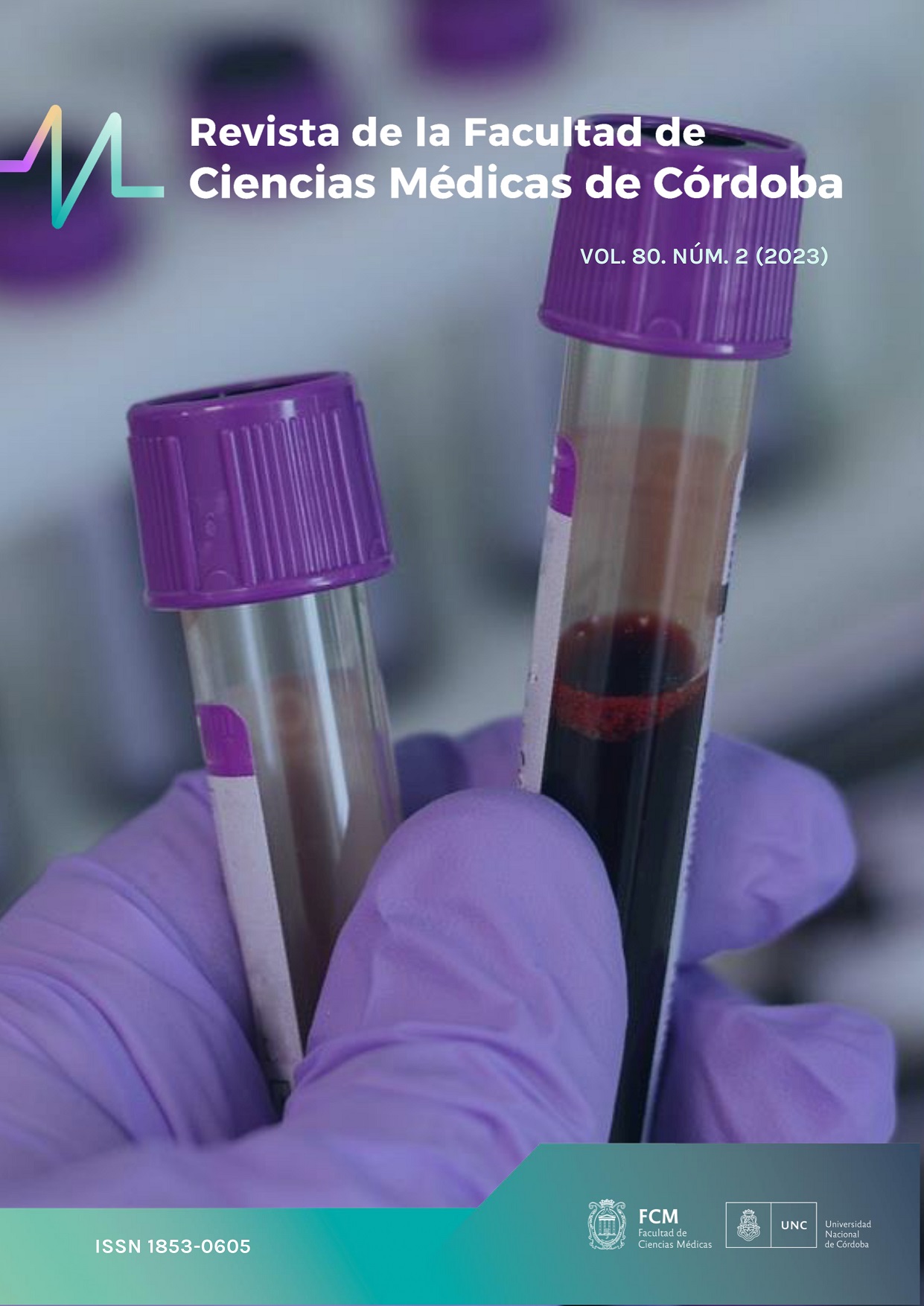Mortalidad y recurrencia de la enfermedad tromboembólica venosa en pacientes adultos: cohorte prospectiva
DOI:
https://doi.org/10.31053/1853.0605.v77.n3.27135Palabras clave:
tromboembolia, tromboembolia venosa, ancianoResumen
INTRODUCCIÓN: La enfermedad tromboembólica venosa (ETV) es una patología que aumenta con la edad. Objetivo: comparar la sobrevida de los ancianos y los jóvenes con un primer episodio de ETV aguda y sintomática. MATERIALES Y MÉTODOS: Cohorte prospectiva de casos incidentes de ETV incluidos en el Registro Institucional de Enfermedad Tromboembólica venosa (NCT01372514) del Hospital Italiano de Buenos Aires entre 2012-2014, dividido en grupos jóvenes (17-64 años) y ancianos (≥ 65 años). Todos los pacientes fueron seguidos anualmente para evaluar el tiempo a la recurrencia (progresión o nuevo evento sintomático de ETV) como eventos competitivos en contexto de muerte y sangrado mayor. Se presentaron los riesgos crudos (c) y ajustados (a). RESULTADOS: se incluyeron 446 pacientes, el 63% (292) fueron mayores de 65 años. La sobrevida fue menor en los ancianos comparados con los jóvenes (p 0.007), a los 3 meses 87% vs 95% y al año 73% vs 87%, respectivamente. Los ancianos presentaron un HRc1,71 y HR a 1.68. La recurrencia global fue 5% (IC 95% 3-8) al mes, 6% (IC 95% 4-9) a los 3 meses, 8% (IC 95% 6-11) al año y 13% (IC 95% 9-18) a los dos años. No se encontró asociación entre la edad y la recurrencia sub hazard 0.8(IC 0,34-1,86). El sangrado ocurrió en un 9% (39) de los pacientes. CONCLUSIONES: La mortalidad global en pacientes con ETV confirmada es mayor en la población anciana. No hubo diferencias en relación a la recurrencia de ETV, ni el sangrado y tampoco con la edad.
Descargas
Referencias
1. Geerts WH, Bergqvist D, Pineo GF, Heit JA, Samama CM, Lassen MR, Colwell CW. Prevention of venous thromboembolism: American College of Chest Physicians Evidence-Based Clinical Practice Guidelines (8th Edition). Chest. 2008 Jun;133(6 Suppl):381S-453S. doi: 10.1378/chest.08-0656.
2. Guyatt GH, Norris SL, Schulman S, Hirsh J, Eckman MH, Akl EA, Crowther M, Vandvik PO, Eikelboom JW, McDonagh MS, Lewis SZ, Gutterman DD, Cook DJ, Schünemann HJ. Methodology for the development of antithrombotic therapy and prevention of thrombosis guidelines: Antithrombotic Therapy and Prevention of Thrombosis, 9th ed: American College of Chest Physicians Evidence-Based Clinical Practice Guidelines. Chest. 2012 Feb;141(2 Suppl):53S-70S. doi: 10.1378/chest.11-2288.
3. Silverstein MD, Heit JA, Mohr DN, Petterson TM, O'Fallon WM, Melton LJ 3rd. Trends in the incidence of deep vein thrombosis and pulmonary embolism: a 25-year population-based study. Arch Intern Med. 1998 Mar 23;158(6):585-93. doi: 10.1001/archinte.158.6.585.
4. Vázquez FJ, Posadas-Martínez ML, Vicens J, González Bernaldo de Quirós F, Giunta DH. Incidence rate of symptomatic venous thromboembolic disease in patients from a medical care program in Buenos Aires, Argentina: a prospective cohort. Thromb J. 2013 Aug 1;11(1):16. doi: 10.1186/1477-9560-11-16.
5. Silverstein MD, Heit JA, Mohr DN, Petterson TM, O'Fallon WM, Melton LJ 3rd. Trends in the incidence of deep vein thrombosis and pulmonary embolism: a 25-year population-based study. Arch Intern Med. 1998 Mar 23;158(6):585-93. doi: 10.1001/archinte.158.6.585.
6. Robine JM, Paccaud F. Nonagenarians and centenarians in Switzerland, 1860-2001: a demographic analysis. J Epidemiol Community Health. 2005 Jan;59(1):31-7. doi: 10.1136/jech.2003.018663.
7. Marchiori A, Mosena L, Prins MH, Prandoni P. The risk of recurrent venous thromboembolism among heterozygous carriers of factor V Leiden or prothrombin G20210A mutation. A systematic review of prospective studies. Haematologica. 2007 Aug;92(8):1107-14. doi: 10.3324/haematol.10234.
8. Schulman S, Rhedin A-S, Lindmarker P, Carlsson A, Larfars G, Nicol P, Loogna E, Svensson E, Ljungberg B, Walter H, Viering S, Nordlander S, Leijd B, Jonsson K-A, Hjorth M, Linder O, Boberg J. A comparison of six weeks with six months of oral anticoagulant therapy after a first episode of venous thromboembolism. Obstetrical & Gynecological Survey. 1996;51(1):29-30. doi: 10.1097/00006254-199601000-00015
9. Fang MC, Go AS, Chang Y, Borowsky LH, Pomernacki NK, Udaltsova N, Singer DE. A new risk scheme to predict warfarin-associated hemorrhage: The ATRIA (Anticoagulation and Risk Factors in Atrial Fibrillation) Study. J Am Coll Cardiol. 2011 Jul 19;58(4):395-401. doi: 10.1016/j.jacc.2011.03.031.
10. Kuijer PM, Hutten BA, Prins MH, Büller HR. Prediction of the risk of bleeding during anticoagulant treatment for venous thromboembolism. Arch Intern Med. 1999 Mar 8;159(5):457-60. doi: 10.1001/archinte.159.5.457.
11. Greig MF, Rochow SB, Crilly MA, Mangoni AA. Routine pharmacological venous thromboembolism prophylaxis in frail older hospitalised patients: where is the evidence? Age Ageing. 2013 Jul;42(4):428-34. doi: 10.1093/ageing/aft041.
12. Kearon C, Ginsberg JS, Kovacs MJ, Anderson DR, Wells P, Julian JA, MacKinnon B, Weitz JI, Crowther MA, Dolan S, Turpie AG, Geerts W, Solymoss S, van Nguyen P, Demers C, Kahn SR, Kassis J, Rodger M, Hambleton J, Gent M; Extended Low-Intensity Anticoagulation for Thrombo-Embolism Investigators. Comparison of low-intensity warfarin therapy with conventional-intensity warfarin therapy for long-term prevention of recurrent venous thromboembolism. N Engl J Med. 2003 Aug 14;349(7):631-9. doi: 10.1056/NEJMoa035422.
13. Ruíz-Giménez N, Suárez C, González R, Nieto JA, Todolí JA, Samperiz AL, Monreal M; RIETE Investigators. Predictive variables for major bleeding events in patients presenting with documented acute venous thromboembolism. Findings from the RIETE Registry. Thromb Haemost. 2008 Jul;100(1):26-31. doi: 10.1160/TH08-03-0193.
14. Anderson FA Jr, Wheeler HB, Goldberg RJ, Hosmer DW, Patwardhan NA, Jovanovic B, Forcier A, Dalen JE. A population-based perspective of the hospital incidence and case-fatality rates of deep vein thrombosis and pulmonary embolism. The Worcester DVT Study. Arch Intern Med. 1991 May;151(5):933-8.
15. Goldhaber SZ, Visani L, De Rosa M. Acute pulmonary embolism: clinical outcomes in the International Cooperative Pulmonary Embolism Registry (ICOPER). Lancet. 1999 Apr 24;353(9162):1386-9. doi: 10.1016/s0140-6736(98)07534-5.
16. Robert-Ebadi H, Righini M. Diagnosis and management of pulmonary embolism in the elderly. Eur J Intern Med. 2014 Apr;25(4):343-9. doi: 10.1016/j.ejim.2014.03.009.
17. Zwierzina D, Limacher A, Méan M, Righini M, Jaeger K, Beer HJ, Frauchiger B, Osterwalder J, Kucher N, Matter CM, Banyai M, Angelillo-Scherrer A, Lämmle B, Egloff M, Aschwanden M, Mazzolai L, Hugli O, Husmann M, Bounameaux H, Cornuz J, Rodondi N, Aujesky D. Prospective comparison of clinical prognostic scores in elder patients with a pulmonary embolism. J Thromb Haemost. 2012 Nov;10(11):2270-6. doi: 10.1111/j.1538-7836.2012.04929.x
18. Trujillo-Santos J, Nieto JA, Tiberio G, Piccioli A, Di Micco P, Prandoni P, Monreal M; RIETE Registry. Predicting recurrences or major bleeding in cancer patients with venous thromboembolism. Findings from the RIETE Registry. Thromb Haemost. 2008 Sep;100(3):435-9.
Publicado
Número
Sección
Licencia
Derechos de autor 2020 Universidad Nacional de Córdoba

Esta obra está bajo una licencia internacional Creative Commons Atribución-NoComercial 4.0.
Se permite la generación de obras derivadas siempre que no se haga con fines comerciales. Tampoco se puede utilizar la obra original con fines comerciales.

















